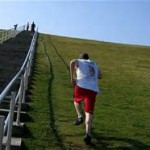Start a Running Program!
So you’re interested in running to help your fitness? A common mistake of many beginning runners is doing too much too soon. Here’s how to get started effectively and safely:
Start with walk/jog intervals. Perform a walking warm up for 10 minutes, then start with 3-5, 10-30 second jogging intervals followed by 1-2 minute walking recovery intervals, complete your workout with a 10 minute walking cool down.
Wear running shoes. Go to your local sporting goods store and ask about running-specific shoes. Proper footwear is essential with high-impact fitness.
Listen to your body. When beginning a running program, listen to your body and level of soreness. Muscle aches are okay when starting new exercise, consistent pain is not.
*Consult your physician before beginning exercise.
 Subscribe
Subscribe






